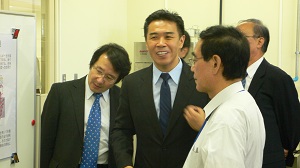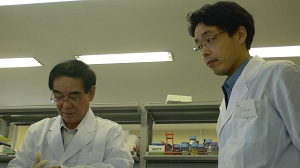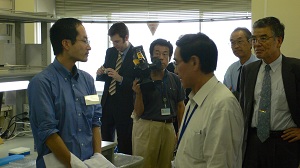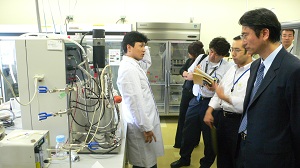Mayor of Kawasaki City visited our lab and listen to a presentation




Mr. Takao Abe, the mayor of Kawasaki City, several city officials along with the press personnel visited our laboratory and RIKEN's in Kawasaki, and Mr. Abe try his hand at protein crystallisation experiment. Dr. Edward Wright of the British Embassy also joined the visitors. Questions such as "What is the most difficult step [of membrane protein crystallography]? ", "Why would knowing the 3D structure of a protein lead to drug discovery tailor-made medicine?" showed high interest and expectation of the public toward structural proteomics, including our project.
"How to make non-speciallists of this field to understand our project is something relevant to them?", this is what we thought hard about while we prepared for the visit. Rie suggested to let them taste miracle fruit and explain how it affect our sense of taste, but we had to abandon the idea as the explanation is somewhat complicated. The fruit make you taste sour food, such as lemon, sweet. Miraculin, a protein contained in the fruit, binds to the active site of sweet taste receptors (embedded in the cell membrane of taste cells on the surface of our taste buds) in the presence of acids, tricking the brains to believe the food is sweet.
These visitors attended the 8th Kawasaki Life Science Network Meeting titled "The Latest of Protein Research -From Kawasaki-" and listened to the presentations "New Development in Protein Research" by Prof. Yokoyama, the Project Director of Protein Research Group, RIKEN, and "ERATO Iwata Human Receptor Crystallography Project" by Prof. Iwata, our Research Director. The meeting was jointly hosted by Kawasaki City, JST, and RIKEN Yokohama Institute.
Iwata Research Director enthusiastically talked about how structural analysis of membrane receptors would improve the quality of life using blood pressure control by ansiotensin, a hormone as an example. He also appealed for research collaboration with companies and academic research laboratories including those in the field of engineering, since aims of our project is technological. The appeal seemed to catch attention of many listeners. May be this is because many of them are from the private sector. It is exciting to see what kind of breakthrough or new technology these collaborations would help to create. Just as Iwata Research Director stressed in his presentation, the situation surrounding structural analysis of membrane protein at present is very similar to that of soluble protein when the number of solved structures skyrocketed in pace with the development of relevant technologies. We are excited and feel very fortunate to work on a project like this in such a dynamic time.